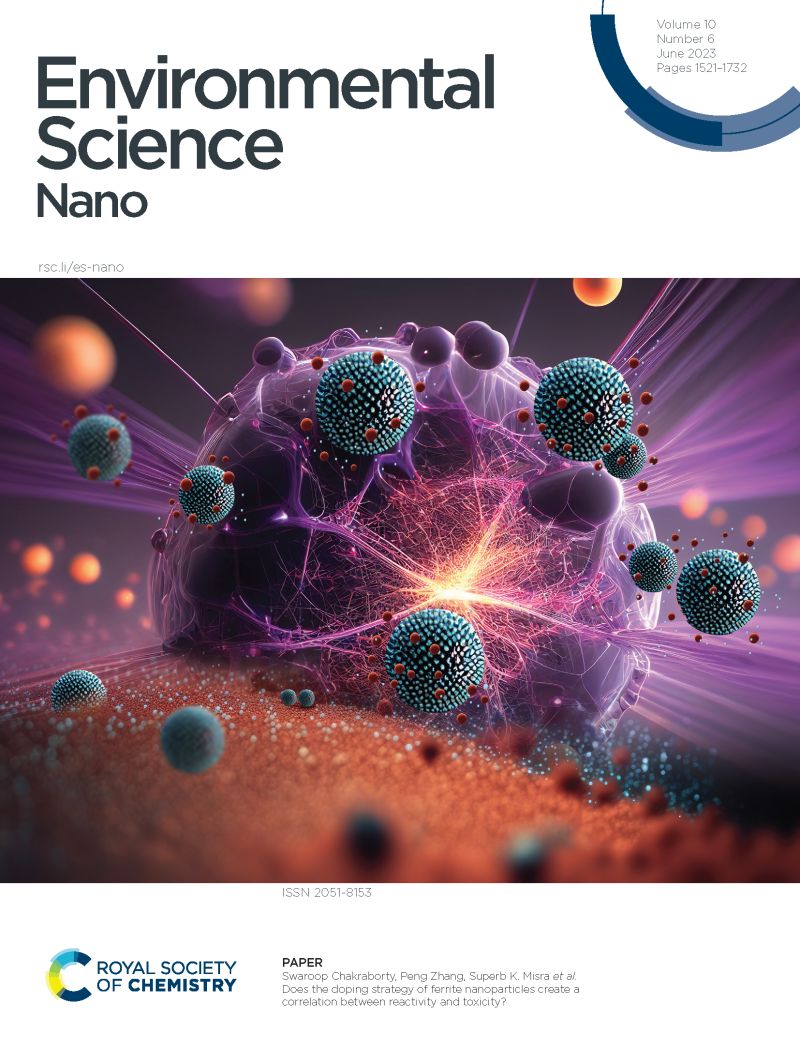多营养素纳米复合材料增强生菜抗紫外线胁迫能力,调节生菜营养积累
IF 5.8
2区 环境科学与生态学
Q1 CHEMISTRY, MULTIDISCIPLINARY
引用次数: 0
摘要
本研究介绍了一种新型的多元素(锌-镁-锰-铁)纳米复合材料,该复合材料既可以作为莴苣的紫外线保护剂,又可以作为莴苣的营养输送系统。植物在室内盆栽土壤中生长,在人工照明(发光二极管,LED)或LED+紫外线辐射下生长,以模拟过度的阳光照射(光胁迫)。在生菜生长的第5周,在叶片上分别施用100 mg/L、200 mg/L和300 mg/L的纳米复合材料,每株施用1 mL(每株分别施用0.1、0.2或0.3 mg复合材料)。在两周的时间里,植物每天暴露在紫外线辐射(360-400 nm)下10小时。与未处理和离子对照相比,300 mg/L处理显著提高了植物的光合效率和生长,叶绿素含量(66.7%±3.5),叶面积(45%±2.1)和干生物量(43.68%±1.8)。与对照相比,它还减轻了紫外线诱导的应激,将紫外线诱导的损伤评分降低了73%,并降低了应激标志物,类黄酮产量降低到对照水平的30.5%±2.3,SOD活性降低到对照水平的25.8%±1.8。复合控制的养分释放机制促进了Mg的快速吸收(4天内叶片吸收220 Mg /kg干重)和Zn、Mn和Fe在7 - 10天内的持续输送。长期营养摄取分析显示,Mn(55.3%±3.2)、Mg(47.8%±2.7)和Fe(62.5%±4.1)增加。P(28.5%±2.2)和K(35.7%±3.1)积累的增加进一步提高了可食组织的营养品质。此外,纳米复合材料显示出将有害紫外线辐射转化为可见光的独特能力,提供紫外线防护和增强光合活性的双重好处。这些发现突出了这种多功能纳米复合材料作为一种可持续解决方案的潜力,可以提高作物的抗逆性,优化养分输送,并在农业系统中对抗环境压力。本文章由计算机程序翻译,如有差异,请以英文原文为准。
A multi-nutrient nanocomposite enhances UV stress tolerance and modulates nutrient accumulation in lettuce
This study introduces a novel multielement (Zn-Mg-Mn-Fe) nanocomposite that serves both as a UV-protective agent and a nutrient delivery system for Lactuca sativa (lettuce). Plants were grown indoors in a potting soil-like mix, under artificial lighting (from light emitting diodes, LEDs) or under LED+UV radiation to simulate excessive sunlight exposure (light stress). Lettuce was treated with foliar applications of the nanocomposite at 100 mg/L, 200 mg/L, and 300 mg/L, with 1 mL applied per plant during the fifth week of growth (a total of 0.1, 0.2 or 0.3 mg of the composite respectively per plant). Plants were exposed to UV radiation (360–400 nm) for 10 hours daily over two weeks. The 300 mg/L treatment significantly enhanced photosynthetic efficiency and plant growth, increasing chlorophyll content (66.7% ± 3.5), leaf area (45% ± 2.1), and dry biomass (43.68% ± 1.8) compared to untreated and ionic controls. It also mitigated UV-induced stress, reducing UV-induced damage scores by 73% compared to controls and lowering stress markers, with flavonoid production reduced to 30.5% ± 2.3 of control levels and SOD activity reduced to 25.8% ± 1.8 of control levels. The composite’s-controlled nutrient release mechanism facilitated rapid Mg uptake (220 mg/kg dry weight in leaves within 4 days) and sustained delivery of Zn, Mn, and Fe over a 7–10-day period. Long-term nutrient uptake analysis showed increases in Mn (55.3% ± 3.2), Mg (47.8% ± 2.7), and Fe (62.5% ± 4.1). Enhanced P (28.5% ± 2.2) and K (35.7% ± 3.1) accumulation further boosted the nutritional quality of edible tissues. Additionally, the nanocomposite demonstrated the unique ability to convert harmful UV radiation into visible light, providing dual benefits of UV protection and enhanced photosynthetic activity. These findings highlight the potential of this multi-functional nanocomposite as a sustainable solution to improve crop resilience, optimize nutrient delivery, and combat environmental stress in agricultural systems.
求助全文
通过发布文献求助,成功后即可免费获取论文全文。
去求助
来源期刊

Environmental Science: Nano
CHEMISTRY, MULTIDISCIPLINARY-ENVIRONMENTAL SCIENCES
CiteScore
12.20
自引率
5.50%
发文量
290
审稿时长
2.1 months
期刊介绍:
Environmental Science: Nano serves as a comprehensive and high-impact peer-reviewed source of information on the design and demonstration of engineered nanomaterials for environment-based applications. It also covers the interactions between engineered, natural, and incidental nanomaterials with biological and environmental systems. This scope includes, but is not limited to, the following topic areas:
Novel nanomaterial-based applications for water, air, soil, food, and energy sustainability
Nanomaterial interactions with biological systems and nanotoxicology
Environmental fate, reactivity, and transformations of nanoscale materials
Nanoscale processes in the environment
Sustainable nanotechnology including rational nanomaterial design, life cycle assessment, risk/benefit analysis
 求助内容:
求助内容: 应助结果提醒方式:
应助结果提醒方式:


